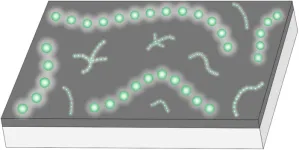(Press-News.org) The genomes of two hornet species, the European hornet and the Asian hornet (or yellow-legged hornet) have been sequenced for the first time by a team led by UCL (University College London) scientists.
By comparing these decoded genomes with that of the giant northern hornet, which has recently been sequenced by another team, the researchers have revealed clues suggesting why hornets have been so successful as invasive species across the globe.
Hornets are the largest of the social wasps; they play important ecological roles as top predators of other insects. In their native regions, they are natural pest controllers, helping regulate the populations of insects such as flies, beetles, caterpillars and other types of wasps. These services are critical for healthy, functional ecosystems, as well as for agriculture.
But hornets also tend to be very successful as invasive species. They can become established in areas they are not native to and cause potentially huge ecological and economic damage by hunting important pollinators, such as honeybees, wild bees and hoverflies.
To better understand how these species have so successfully expanded their ranges, the international team of scientists investigated the genomes of three types of hornets.
A genome sequence is the set of instructions – a genetic code – that makes a species. Comparing the genomes of different species can give insights into their biology – their behaviour, evolution, and how they interact with the environment.
The researchers have newly sequenced the genomes of the native European hornet, Vespa crabro – an important top predator, which is protected in parts of Europe – and the invasive yellow-legged Asian hornet Vespa velutina, which has become established through much of Europe over the last 20 years threatening native ecosystems, and has occasionally been sighted in the UK. They compared these with the genome of the giant northern hornet, Vespa mandarinia – a species known for its role as pest controller, pollinator and food provider in its native Asian range, but is a recent arrival in North America, where it may threaten native fauna.
By analysing differences between the three related species, the researchers were able to identify genes that have been rapidly evolving since the species differentiated themselves from other wasps and from one another, and found some noteworthy genes that are rapidly evolving, particularly relating to communication and olfaction (smell).
The study’s first author, Dr Emeline Favreau (UCL Centre for Biodiversity & Environment), said: “We were excited to find evidence of rapid genome evolution in these hornet genomes, compared to other social insects. Lots of genes have been duplicated or mutated; these included genes that are likely to be involved in communication and in sensing the environment.”
Genome evolution allows organisms to adapt to their environment and make the most of their surroundings by developing new behaviours and physiology.
Co-author Dr Alessandro Cini, who began the work at UCL before moving to the University of Pisa, said: “These findings are exciting, as they may help explain why hornets have been so successful in establishing new populations in non-native regions.
“Hornets are carried to different parts of the world accidentally by humans. All that is needed is a small number of mated queens to be transported, hidden in cargo perhaps. The genomes suggest that hornets have lots of genes involved in detecting and responding to chemical cues – these may make them especially good at adapting to hunt different types of prey in non-native regions.”
Senior author Professor Seirian Sumner (UCL Centre for Biodiversity & Environment) said: “These hornet genomes are just the beginning. The genomes of more than 3,000 insect species have now been sequenced by efforts around the world, but wasps are under-represented among these.
“Genomes tell us about aspects of the ecology and evolution that other methods cannot. Evolution has equipped these insects with an incredible genetic toolbox with which to exploit their environment and hunt their prey.”
Armed with these new genomes, the scientists hope to help improve the management of hornet populations, both for their ecosystem services as pest controllers in native zones, and as ecological threats in regions where they are invasive.
The study involved researchers in the UK, Italy, Spain, Israel, France, New Zealand, and Austria, and was primarily funded by the Natural Environment Research Council.
END
Newly sequenced hornet genomes could help explain invasion success
2023-04-21
ELSE PRESS RELEASES FROM THIS DATE:
The right sports bra may increase your running performance by 7%
2023-04-21
Running is one of the most accessible forms of exercise with an array of proven cardiovascular and musculoskeletal benefits, and an added bonus of increased mental health. Good quality running gear, such as the right pair of shoes, is vital to improve running performance and reduce injury risk. For women particularly, a well-designed sports bra protects from exercise-induced breast pain, which can be a significant barrier to practicing sports. Up to 72% of women experience breast pain while running.
Previous research has shown that the increased ...
SwRI-led team successfully observes Australian eclipse in preparation for 2024 US eclipse
2023-04-21
SAN ANTONIO – 4.20.23 -Scientists from Southwest Research Institute (SwRI) led a team in the unique Citizen Continental-America Telescopic Eclipse (CATE) experiment to image the Sun’s outer atmosphere, the corona, during a short solar eclipse on the opposite side of the Earth. Using four platforms in the northwest corner of Australia, the team successfully observed the million-degree solar corona at the April 20 eclipse viewed from the Exmouth peninsula. The Australian eclipse serves both as a unique scientific opportunity and a training exercise for the program’s leadership in preparation ...
When an earthquake strikes, how do Mexico city hospitals respond?
2023-04-21
Staff in public and private hospitals in Mexico City are likely to follow well-established and reinforced earthquake early warning (EEW) protocols for evacuation, according to an ongoing study.
Overall, staff are likely to follow the protocols especially when they are “reinforced with drills that help practice the correct protective action,” said Sandra Vaiciulyte of Universidad Nacional Autónoma de México. She discussed her research at the Seismological Society of America (SSA)’s 2023 Annual Meeting.
In the study, there have been “no accounts of injuries of patients and staff because of the particular reaction by staff,” ...
The mental health of pediatric ICU teams: how has the pandemic affected these professionals?
2023-04-21
Concern about the mental health of hospital professionals has been increasing in recent years, and when, in early 2020, the Covid-19 pandemic was declared and rapidly spread, there was a large increase in the overload of workers in Intensive Care Units (ICUs). Given this, researchers from the D’Or Institute for Research and Education (IDOR) and other national institutions assessed the prevalence and extent of psychological disorders such as burnout, anxiety, depression, and post-traumatic stress disorder ...
Ridgecrest faults increasingly sensitive to solid Earth tides before earthquakes
2023-04-21
Faults in the Ridgecrest, California area were very sensitive to solid earth tidal stresses in the year and a half before the July 2019 Ridgecrest earthquake sequence, researchers reported at the Seismological Society of America (SSA)’s 2023 Annual Meeting.
“The signal of tidal modulation becomes extremely strong” after 2018, said Eric Beauce of Lamont-Doherty Earth Observatory, who noted that the signal was identified with seismicity that occurred around the faults that broke in the 2019 magnitude 7.1 earthquake.
The link ...
New study reveals that childhood adversity is linked to an increased risk of developing type 2 diabetes as young adults
2023-04-21
A new study published in Diabetologia (the journal of the European Association for the Study of Diabetes [EASD])finds that individuals who experienced childhood adversity are at increased risk of developing type 2 diabetes (T2D) in early adulthood.
The research was conducted by Assistant Professor Leonie K. Elsenburg and colleagues at the Section of Epidemiology, Department of Public Health, University of Copenhagen, Copenhagen, Denmark and aimed to determine whether there was a link between childhood adversity and the development ...
Reducing fatigue and errors among nurses working night shifts
2023-04-21
Nurses exposed to 40 minutes of bright light before their night shifts feel less fatigued and make fewer errors at work, according to a study led by McGill University. The nurses also slept better after their shifts.
“Healthcare workers are experiencing high levels of fatigue due to staffing shortages, difficult schedules, and heavy workloads. Further, the cost of medical errors has been estimated at tens of billions of dollars per year in North America,” says Jay Olson, the senior author of the recent study in Sleep Health, ...
Surgery most effective treatment of metabolic liver disease
2023-04-21
Metabolic (bariatric) surgery is more effective than medications and lifestyle interventions for the treatment of advanced non-alcoholic fatty liver disease.
A new paper, published today in The Lancet by King’s College London and the Catholic University of Rome, is the first to compare three active treatments of non-alcoholic Steatohepatitis (NASH) and to specifically investigate the effectiveness of metabolic surgery (weight loss surgery) in a randomised clinical trial.
Non-Alcoholic Fatty Liver Disease (NAFLD) is the most common cause of chronic liver disease, globally affecting 55% of people with type 2 diabetes and 75% of those with obesity. Non-alcoholic ...
Whales stop by Gold Coast bay for day spa fix with full body scrubs
2023-04-21
A new Griffith University study has found that humpback whales will use sandy, shallow bay areas to ‘roll’ around in sandy substrates to remove dead skin cells on their return journeys south to cooler waters.
Marine ecologist Dr Olaf Meynecke, from the Griffith-led Whales and Climate Research Program and Coastal and Marine Research Centre, used suction cup tags to track southward migrating whales between August 2021 and October 2022.
The CATS tags are fitted with integrated high-definition video, magnesium release system, a VHF transmitter for retrieval, magnetometers, ...
Horodyskia is among the oldest multicellular macroorganisms: Study
2023-04-21
Horodyskia, characterized by a string of beads with uniform size and spacing, is a kind of macroscopic fossil with a record extending from the early Mesoproterozoic Era (~1.48 Ga) to the terminal Ediacaran Period (~550 Ma).
Now, researchers led by Dr. LI Guangjin and Prof. PANG Ke from the Nanjing Institute of Geology and Palaeontology of the Chinese Academy of Sciences (NIGPAS) and Prof. CHEN Lei from Shandong University of Science and Technology have revealed that Horodyskia is among the oldest multicellular macroorganisms and may have attained its macroscopic ...


